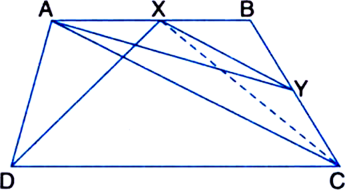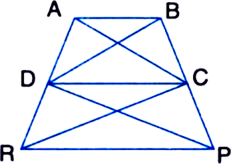 Long Answer Type
Long Answer Type
 Short Answer Type
Short Answer TypeIn figure, ABCDE is a pentagon. A line through B parallel to AC meets DC produced at F. Show that
(i) ar(ΔACB) = ar(ΔACF)
(ii) ar(□AEDF) = ar(ABCDE). 

To Prove: ar(ΔADX) = ar(ΔACY).
Construction: Join CX.
Proof: ∵ ΔADX and ΔACX are on the same base AX and between the same parallels AB and DC.
∴ ar(ΔADX) = ar(ΔACX) ...(1)
Two triangles on the same base (or equal bases) and between the same parallels are equal in area ∵ ΔACX and ΔACY are on the same base AC and between the same parallels AC and XY.
∴ ar(ΔACX) = ar(ΔACY) ...(2)
Two triangles on the same base (or equal bases) and between the same parallels are equal in area From (1) and (2), we get ar(ΔADX) = ar(ΔACY).

Show that the area of a rhombus is half the product of the lengths of its diagonals.
Or
Prove that the area of a rhombus is equal to half the rectangle contained by its diagonals.
